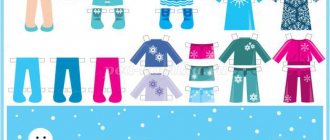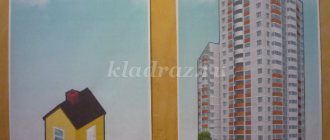MAGAZINE Preschooler.RF
Observation summary for the walk “We are walking along the path into the forest” for children of the first junior groupCompleted by teacher: Pernitskaya V.G.G. Mezhdurechensk 2022 MBDOU No. 27 “Rosinka”
Purpose: Observing natural objects while walking; fostering respect for nature; expanding children’s understanding of the structure, growth and development of plants, developing the ability to generalize them according to essential features; instilling in children a humane attitude towards living things; development of coherent speech, interest in artistic expression.
Tasks:
Educational: Contribute to the generalization of children’s ideas about the structure, growth and development of plants; develop the ability to generalize based on essential features; expand your understanding of plant parts; teach kids to take care of plants and know their needs. Enrich children's vocabulary, develop their coherent speech, and interest in artistic expression.
Developmental: Develop and maintain cognitive activity, basic initiative and independence in learning about plants and caring for them.
Educational: Cultivate interest in plants, gain experience in an attentive and caring attitude towards them.
Sequential course of observation.
Get children interested in the appearance of the Katya doll.
Doll Katya has never been on a walk with children and does not know what tall trees look like. The children happily agree to take her for a walk and introduce her to the trees growing on the territory of the kindergarten.
Examining and finding differences between trees and shrubs.
Draw children's attention to plants. Remember the forms, parts of the plant, what conditions are necessary for normal growth and development, what function the parts of the plant have (trunk, roots, leaves), how trees and shrubs differ from each other and what similarities they have (find them on the site, examine them) .
Conversation about the forest.
Give children the idea that a forest is a community of plants and animals that live together and need each other. The forest is similar to a park where children often walk with their parents, only much larger. The most important inhabitants of the forest are trees, there are many of them, they are tall. Animals, birds, and insects live in the forest. They find housing here: they dig holes and build nests. The forest feeds them. Animals and birds eat various parts of plants: seeds, berries, tree branches, leaves, etc. Animals are afraid of people. They should not be frightened or offended. Predatory animals live in the forest; they are dangerous to other animals and humans. You can't get close to them. Wild animals do not attack people without reason, but try to escape.
P/n: “Who lives in the forest?” Encourage children to depict the movements of animals and birds.
Getting to know the trees on the site.
So what are we going to talk about today? That's right, about trees. Do you like to walk? What do you see in the yard and in the park? Do you know what these trees are called?
Introduce children to birch. Tell that birch is a tree. It's alive. It has a trunk, branches, and leaves will soon appear. A tree always has one trunk. It comes in thick and thin. Birch grows on our site. The birch tree has one white trunk with black spots. Read the lines from A. Prokofiev’s poem: “You recognize it by a simple sign, There is no whiter tree in the world!”
Bring the children to the spruce tree. Remember the song, poems about the Christmas tree. Tell that spruce is a slender tree. The spruce looks especially beautiful in winter, when the rest of the trees are bare, but it is green and there is frost on its branches. The tree remained green because its branches, instead of leaves, had small needles and cones. You can constantly admire the spruce; it decorates the area.
Artistic word:
What kind of girl is this?
Not a seamstress. Not a craftswoman.
She doesn’t sew anything herself,
And in needles all year round. (Spruce)
There are many trees around us. And here is the beautiful rowan. There are berries preserved on the rowan tree. There is white snow on the red berries. Birds fly in and peck the rowan berries.
Questions: Are there berries on rowan branches? Where do you think they disappeared to? What color paint can you use to paint rowan berries?
Artistic word:
“And the rowan tree near the old barn is frozen into frost.
When the time for snowstorms arrived, waxwings flew in,
They whistled and whistled and everyone ate every berry.”
The trees are tall. The wind shakes the branches of the trees.
Physical education lesson: “The wind is blowing in our faces, the tree is swaying...”
Consider the bush. Clarify children's understanding of the main parts of a bush (several trunks, branches, leaves). Give them a visual representation that shrubs come in different heights.
Expand your understanding of trees.
In winter, trees stand without leaves. Snow falls on the trees. In winter, trees covered in snow are very beautiful. In spring, trees wake up and green leaves appear on them. On all trees they are green, but they are all different in size. In summer, many trees bear fruits and berries. Animals and people eat them. To keep trees healthy and beautiful, you must not break branches or tear leaves. You need to care for garden trees - water them, loosen the soil.
Invite children to answer the questions:
-What does the tree have? (trunk, branches, leaves, roots)
-What are trees for? (so that the air is clean, it is beautiful, etc.)
— To keep trees from getting sick and to be beautiful, what shouldn’t you do? (break branches, tear leaves, etc.)
— Why do we care for plants? (so that they are beautiful, grow well and bloom).
The doll Katya thanks the children for an interesting and educational walk.
| Next > |
Progress of observation.
Tell us about the structure of the spruce: the trunk is covered with brown bark, there are many branches that gradually increase in size downwards. All branches are covered with hard, prickly needles and brown cones. Invite children to stroke the trunk, press their cheeks against it, and touch the needles so that they get not only a visual, but also a tactile idea. The prickly green one was cut down with an axe. The prickly green one comes to our house.
Labor activity
Collecting fallen leaves around trees, caring for broken branches. Goals: - to encourage children to independently carry out basic tasks.
Outdoor games
"On a smooth path"
.Goals: - develop coordination of movements of arms and legs; — teach to walk freely in a column one at a time.
Individual work
Goal: Development of balance.
Remote materials: Masks-medals for outdoor games, scoops, rakes, buckets, toys, cars, molds.
November.
Walk 1
Observing frost patterns.
Goal: look at the frosty patterns on the window.
Progress of observation.
Tell the children: next to the house there is a small house - a booth in which an animal lives. This beast growls menacingly, barks loudly, has sharp teeth, and gnaws bones. Who is this beast?
Labor activity:
Feeding birds. Purpose: to encourage children to independently carry out basic tasks.
Outdoor games:
"We are funny guys"
.Goals: - clearly
pronounce the text in the game , follow the rules of the game;
- coordinate your actions with the actions of your comrades. Individual work
Goal: Development of balance.
Take-out materials: Bird food, dolls dressed for the weather, scoops.
Walk 9
Observation of the flora.
Objectives: - to introduce the structure of a tree; - cultivate a caring attitude towards nature.
Progress of observation
Without waiting for the warmth in the middle of a winter day, the flowers bloomed on my window. I approached the flowers, my cheek became wet because I lightly touched the window. I approached the flowers, but they did not smell. Why did they grow up on winter days? Observe the frosty patterns on the glass. What are they like? Let the children compare the patterns on different windows. Does frost draw the same patterns? Which patterns turned out the most beautiful? What happens if you touch windows with patterns with your finger?
Labor activity
Shoveling snow to a specific location.
Goal: to teach children to maintain cleanliness and order in the kindergarten area.
Outdoor games
"Catch up with your mate"
.Goals: - perform movements at the teacher’s signal; - clearly navigate when finding your match.
"Don't get caught"
.Goals:—exercise running in different directions; - develop slow and fast running, spatial orientation.
Individual work: develop running in different directions.
Removable material: Wooden spatulas.
Walk 2
Cloud watching.
Goal: to form concepts about clouds and clouds.
Progress of observation
Bring the children to the garden. Remember what they saw at the beginning of autumn. (Onions, potatoes, and beets grew in the beds.)
Then the children were engaged in harvesting and then planting garlic. Now all the beds are covered with snow. Snow covered the ground and the roots of the fruits. The more snow there is in the garden, the warmer it will be for the strawberries and garlic.
Labor activity
Making snow buildings. Goals: - teach how to properly carry snow for construction; — help comrades in performing work activities; - learn how to properly build a house out of snow, compare the size of the house with the size of the toy, carefully and deep enough to cut a hole (door)
.
Outdoor games
"Owl"
.Goal: to teach coordinated actions when signaled by the teacher.
"Blind Man's Bluff"
.Goal: act quickly when losing balance.
Removable materials: Shovels, sleds, buckets, scoops.
Walk 4
Observation of seasonal phenomena - frost, frost.
Goal: to form an idea of frost as one of the states of water.
Progress of observation
Look at the treetops. Which way do they lean? Where does the wind blow from? Raise the flags above your head and see in which direction the flag flutters. Children determine the direction of the wind by fluttering canvases. Invite children to run with a flag in the direction of the wind and against it.
Labor activity
Raking snow from the paths. Goals: - to teach to maintain cleanliness and order in the kindergarten area; - to encourage adults to provide assistance.
There is a lot of snow, there is no place to run, There is also snow on the path. Here are the shovels for you guys, let's work for everyone.
Outdoor games
"Sparrows and the cat"
.Goals: - learn to jump softly, bending your knees; - run without touching each other, dodge the catcher; - be careful.
"Living Labyrinth"
.Goal: to develop a sense of balance, agility, and speed of movement.
Individual work: develop coordination in running without bumping into each other.
Take-out materials: Flags, masks for outdoor games, molds, sticks.
Walk 7
Bush watching.
Objectives: - to form an idea of the main parts of the bush; - cultivate a caring attitude towards the plant world.


